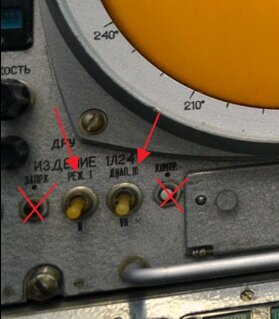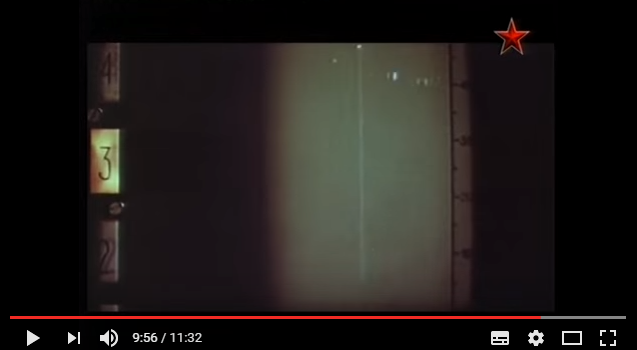BUK crew had very limited information about the target
In this post I will explain the limited data available to the crew of the BUK TELAR. This plus the assumption from other sources made the crew decide to shot down the target, fully convinced they shot down an Ukraine transport aircraft.
MH17 was shot down by a missile launched from a BUK TELAR. The BUK TELAR was highly likely operating in autonomous mode. This means the TELAR has no data link to a seperate radar and control post vehicle and has very limited tools to identify aircraft.
A very comprehensive description of the BUK systen, missile types, warheads and much more can be read here.
The crew has a primary radar screen which is used to search for targets. Crew just sees a moving dot on the screen. No information on type of aircraft, flightnumber like an air traffic controller has.
The radar shows the radial speed of the target. That is the speed of the object relative to the radar antenna. As MH17 flew almost exactly towards the BUK, the radial speed was such the crew must have been able to understand the target was not a slow flying aircraft like a SU-25.
Lets see what information the BUK TELAR has which the crew could use to identify the target :
- direction of the target
- distance of the target to the TELAR
- radial speed of the target
- altitude of the target
- identification friend or foe (IFF)
- NCTR
Distance of the target and the radial speed is shown in the image below. This info is not shown on the radarscreen but on a seperate display. Speed is indicated in units of 10 m/s
The speed of a Boeing 777 (900 km/h) will be displayed as “25”. The speed of an Antonov An-26 which is about 450 km / h will be displayed as “13”.
Operators of the BUK are probably trained to identify targets based on the speed range. Anything below the speed indicator 33 is regarded as subsonic. Anything above 33 is a fighterjet or cruise missile flying a supersonic speeds.
So this is one of the reasons a B777 could be mistaken for an Antonov26.
The altitude of the target is also not so clearly presented. Below the distance and speed indicators there is the height indicator. On the scale you see 0,5, 1, 1,5 and 2. The altitude needs to be multiplied by 10 to get the altitude of the target in kilometers. So 1 is target at 10 km. An Antonov would fly at around 7 km. So on the scale 0,7.
It is clear there is hardly any difference on the scale between 0.7 and 1.
Mind speed and altitude, two values to identify a target, become only available after the target has been selected on the radar screen. (lock and track mode).
Identification friend or foe
To identify enemy aircraft the BUK TELAR is equiped with a system called Silicon-2M ((Кремний-2). This identify friend of foe system shows on the radar screen if the target is a friendly aircraft, an enemy aircraft or a civilian aircraft. Silicon-2M was replaced a few years ago by a new IFF system called Password (Пароль). All of the military aircraft were upgrade to Password but part of the civil aircraft in Russia still use the old system. Silicon-2M is also used by Ukraine military and some older former Sovjet civil aircraft. Aircraft in all other countries do not have a IFF transponder. These aircraft like the Malaysian B777 will be displayed as an unknown/enemy aircraft on the radar of the BUK.
The photo below shows some toggles to select IFF mode. A military aircraft not operating for the Russian Air Force would be displayed on the large radarscreen as enemy. The same applies for any civil airliner.
The switch on the right is labeled “Диап. III” (rus “Диапозон III”). The switch and button is used to interrogate the target. When the button is pressed the, IFF system sends a code to the transponder of the target. If the IFF transponder does not respond with the correct “password” the target is considered enemy. You also see the label 1Л24 . This is the ground radar interrogator which is mounted in radar equipment for air defence systems. Probably a device like the one on the right is installed in the BUK for IFF.
The IFF identification could have caused another couple of seconds which were not used to really check speed and altitude to see if these match an Antonov.
The big circle on the left is the radar screen. It shows the aircraft flying within reach of radar. Type is R4-SA
The rectangle screen is the missile guidance (станция наведения) screen R4-V. I guess this screen can be used to adjust the illumination beam which guides the missile to its target. It has nothing to do with identification of the target.
BUK’s radar search target by 6 degrees sectors (for vertical position). The radar has 3 radar’s positions: “низ” (down, vertical sector degrees 0-6), “ручной режим” (manual mode by lines — 1 degrees — see below) and “верх” (up, vertical sector degrees 6-12).
You can see buttons from left of the screen — it’s a search “line”. One line is 1 degree sector (total 6 degrees). You can search auto (need 4 seconds for 1 cycle) or set search line manually.
target’s zone of destruction (or affected area — it’s a target zone (distance/height) there we can launch missile and hit the target with a given accuracy). That’s zone will be different for every target and depends on many parameters.
Besides radar the BUK also has an optical system. The TOV (tv-optical visor) is used by the crew to visually check the target. However in cloudy conditions the target cannot be seen by the eye and operator has radar only.

Below a screenshot of the information at the R4-V screen. It just shows some dots. (taken from ).
non-cooperative target recognition
There is also NCTR or non-cooperative target recognition. This systems analyses the pattern of the radar returns. It can determine the type of aircraft by a typcial footprint of the radar return Also jet engine modulation, or the analysis of beats and harmonics in the radar return that are caused by engine fan or compressor blades is used to determine type of target. The return is kind of unique for each type of aircraft because of its size, number of engines, speed etc.
I am not sure in what way NCTR is used. My guess one of the two operator has a headset and listens to the sound of the radar returns.
Launch key
A BUK missile cannot be launched by pressing a button. The commander in the TELAR needs to insert a special key before the launch button can be used. This photo shows the launch keys. The keys are attached to a chain which is attached to the BUK TELAR.
To prevent detection of the BUK TELAR by enemy aircraft, the radar is switched off as much as possible. The radar signal can easily be detected by aircraft. Once detected, a BUK TELAR is an easy target for ground attack aircraft like the SU-25.
BUK operations include the usage of so called spotters. These are people who are located in a distance of about 30-50 from the BUK baterry. If these spot a target using their eyes and binoculars, the give a phone call or radio call to the BUK crew. The BUK crew will then switch on the radar and start searching for the target.












If it was a mistake, why is it a crime that has to be prosecuted?
What is different from iran Air 655 or Siberian Airlines 1812?
RUS terrorists are not allowed to fire missiles at ANYTHING – let alone a civilian airliner. Cover-up is also a crime. Putin has been lying all along that RUS is not involved in conflict – yet here they are with advanced surface to air missiles and probably RUS crew.
This would give grounds for civil and criminal prosecution, reparations, etc.
RUS is still lying about the whole thing and denying justice to victims.
SA1812: Missile “overshot” the original target or failed to self detonate. A training accident.
IA655: US Ship was not defending US. I think they were on international waters (legally?). They thought Iran is attacking their ship. They did not understand the risk / be cautious enough. They tried to defend themself. The results is a crime.
MH17: RU sent (illegally) their army to attack Ukraine troops. Their illegally sent BUK and crew shot a civilian plane. Most likely the crew thought they are defending themself or their nearby army. They were not cautious enough. A crimes.
(And yes, Ukraine should have closed the airspace, when it was evident “rebels” were trying to get a BUK, not to trust RU professionalism in air defense. Criminal level of incompetence.)
SA1812 – Ukraine acknowledged the shoot-down and settled with affected parties ($15.6 million settlement)
IA655 – US _eventually_ acknowledged the shoot-down and settled with Iran (US$131.8 million settlement)
MH17 – Russia HAS NOT acknowledged the shoot-down and hampers investigation in any way possible. It is more reminiscent to PA103, brought down above Lockerbie, than any of the above.
Because the entire war is not a civil war but invasion of Russia into Ukraine which is denied by Russia. The TELAR crew was from Kursk, Russia. Who sent them there?
Also, one of three versions of the motive is a version (voiced by the head of Security service of Ukraine at the time) that the TELAR crew’s upper commander’s goal was to dupe the TELAR crew to shoot down a Russian airliner (Moscow – Cyprus) full of Russian families with kids over Ukrainian army positions to be used as casus belli:
http://www.sbu.gov.ua/sbu/control/en/publish/article?art_id=129860
>The TELAR crew was from Kursk, Russia.
Ipse dixit doesn’t make this true.
What about that high ranking Russian official that sent that BUK to Ukraine? Was he not aware about dozens of civilian aircrafts flying in that region? Whatever their motives were, sending a BUK there was a crime.
Venice12 asks ‘If it was a mistake, why is it a crime that has to be prosecuted? What is different from iran Air 655….”
In law, ‘mistakes’ with tragic consequences are prosecuted as manslaughter. The BUK crew and their commanders were supposed to exercise due care and take every precaution, and they did not, so under law they can be prosecuted. As for Iran Air 655 the same applies; it seems to me to have been a case of egregious recklessness, so the law should apply. Why the US crew were not prosecuted escapes me, but whatever the reason, the failure to prosecute one crime does not allow another perpetrator to escape due process,
Reason not prosecuted?
Maybe prosecution felt they could not win a criminal case in court?
Maybe Iran withheld evidence that would help them win or lose
Like a domestic violence witness who withdraws testimony.
USA provided everything as far as I know to investigation team in 655
Some of the proceedings are here
http://www.icj-cij.org/docket/index.php?p1=3&p2=3&k=9c&case=79&code=irus&p3=6
Also it was a direct matter settled between parties involved, only Iran and USA IIRC
and I do not believe Iran screamed and demanded a UN governed International investigation or even a review, but I might be wrong on that assumption.
If I remember correctly it was because USA was forthcoming and transparent about their own investigation into themselves.
Fare thee well
Would the IFF system on the BUK Telar identify ICAO codes?
Most likely not.
Not sure if it makes much sense either.
What if enemy illegally use ICAO codes while attacking?
I think TELAR IFF is built to detect only the secret military transponder codes. RU BUK TELAR has codes only for RU military planes.